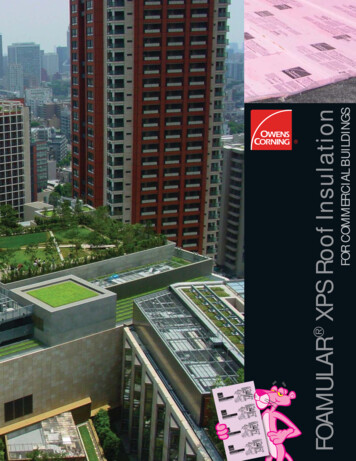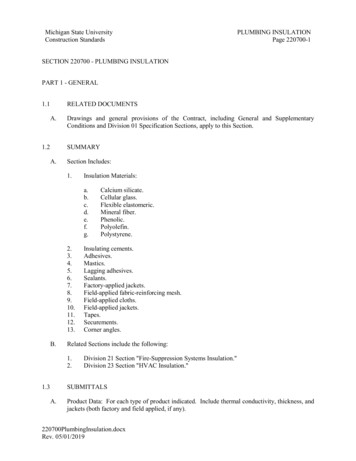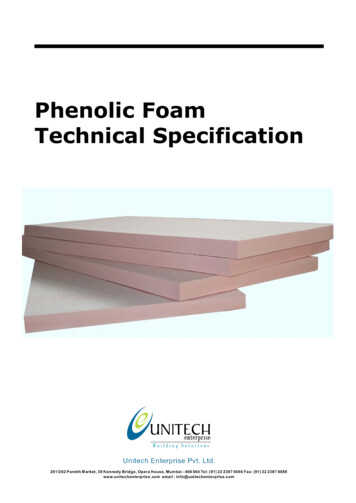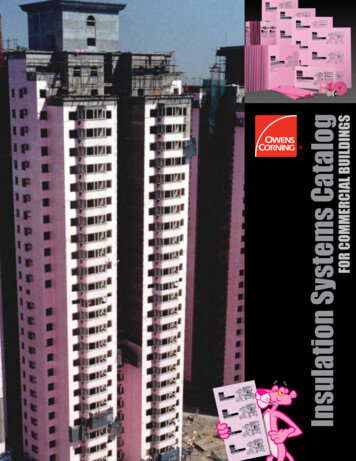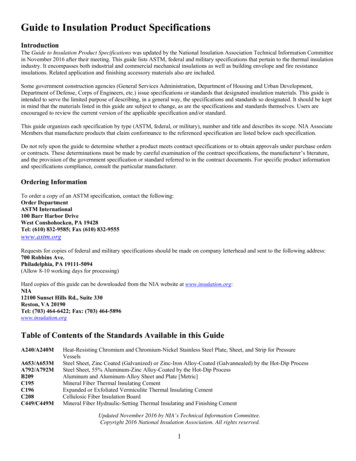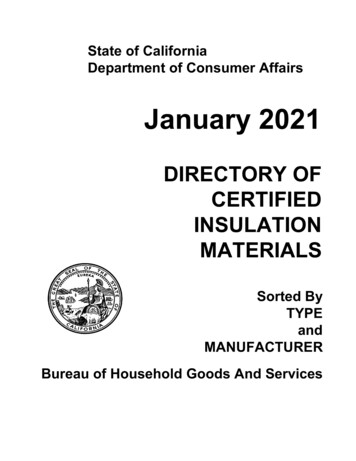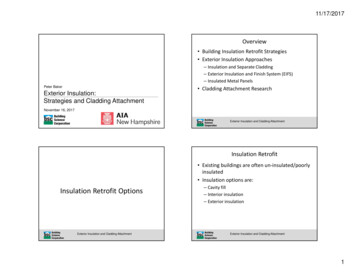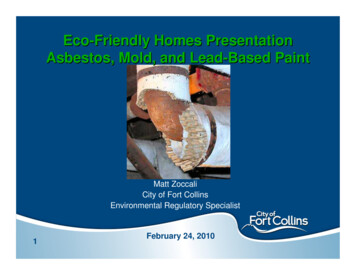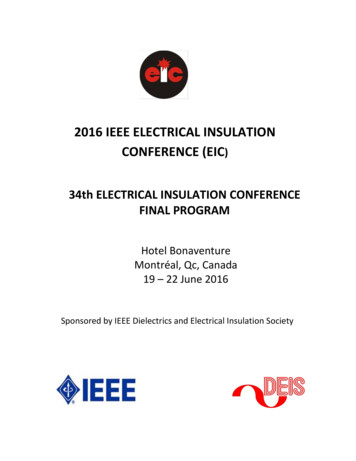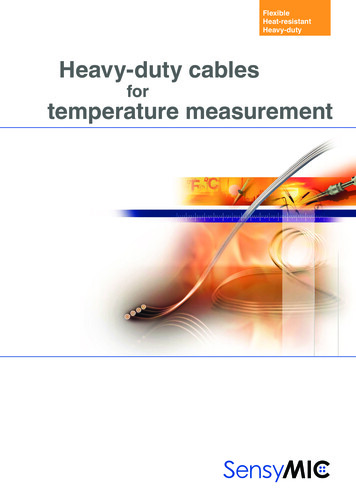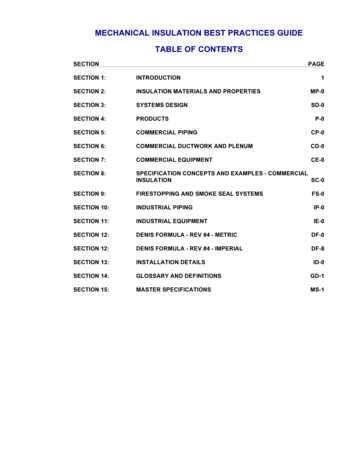
Transcription
MECHANICAL INSULATION BEST PRACTICES GUIDETABLE OF CONTENTSSECTIONPAGESECTION 1:INTRODUCTION1SECTION 2:INSULATION MATERIALS AND PROPERTIESMP-0SECTION 3:SYSTEMS DESIGNSD-0SECTION 4:PRODUCTSSECTION 5:COMMERCIAL PIPINGCP-0SECTION 6:COMMERCIAL DUCTWORK AND PLENUMCD-0SECTION 7:COMMERCIAL EQUIPMENTCE-0SECTION 8:SPECIFICATION CONCEPTS AND EXAMPLES - COMMERCIALINSULATIONSC-0SECTION 9:FIRESTOPPING AND SMOKE SEAL SYSTEMSSECTION 10:INDUSTRIAL PIPINGIP-0SECTION 11:INDUSTRIAL EQUIPMENTIE-0SECTION 12:DENIS FORMULA - REV #4 - METRICDF-0SECTION 12:DENIS FORMULA - REV #4 - IMPERIALDF-8SECTION 13:INSTALLATION DETAILSSECTION 14:GLOSSARY AND DEFINITIONSGD-1SECTION 15:MASTER SPECIFICATIONSMS-1P-0FS-0ID-0
SECTION 1INTRODUCTIONTIAC MECHANICAL INSULATION BEST PRACTICES GUIDEPREFACEThe members of the Thermal Insulation Association of Canada, professionals in themanufacturing, fabrication, distribution and installation or removal of insulation materials, havedetermined that a set of standards consistent across Canada, would be of great benefit to theentire industry.The data presently in publication across Canada varies greatly within the "design and build”community, insulation manufacturers, trade associations, contractors and individual owners orclients. To compile a set of reference materials in one document that can be maintained current,with timely updates, can only improve the economics and quality of the product supplied to theinsulation customer. It will also improve the time required to estimate and the accuracy ofcontracts tendered by contractors.This standard has been developed with the intent to make available a reference which can beutilized for most insulation projects in Canada. The TIAC National Standards are not meant tooverride Provincial and Territorial codes and regulations and other specialized insulation projects.The material selection portion of these standards are not an endorsement of any particularproduct nor is it the intent to suggest that products not included are not to be regarded asunacceptable alternatives.These specifications have been prepared based on manufacturers technical information provided,however it is the specification writer's responsibility to ensure that all products comply withapplicable codes, regulations and standards. The guide specification sections appearing inSection 15 have been structured to comply with specification standards published byConstruction Specifications Canada (CSC), MasterFormat 2004, SectionFormat, andPageFormat.The TIAC Mechanical insulation best practices guide is made up in different sections, focusing onspecific areas of the industry. The document will be updated on a timely basis, to maintain acurrent reference point to assist in system design, material usage and application practice.Revision:I-1
SECTION 2INSULATION MATERIALS AND PROPERTIESSECTION 2:INSULATION MATERIALS AND PROPERTIES2.1DEFINITION OF INSULATION12.2GENERIC TYPES AND FORMS OF INSULATION12.3PROPERTIES OF INSULATION22.4MAJOR INSULATION MATERIALS42.5PROTECTIVE COVERINGS AND FINISHES52.6PROPERTIES OF PROTECTIVE COVERINGS62.7ACCESSORIES72.8SUMMARY - INSULATION MATERIALS AND APPLICATIONWITHIN THE GENERAL TEMPERATURE RANGES82.9INSULATION AND JACKET MATERIAL TABLES11MP-0
SECTION 2INSULATION MATERIALS AND PROPERTIESSECTION 2INSULATION MATERIALS AND PROPERTIES2.1 DEFINITION OF INSULATIONInsulations are defined as those materials or combinations of materials which retard the flow of heatenergy by performing one or more of the following functions:1.Conserve energy by reducing heat loss or gain.2.Control surface temperatures for personnel protection and comfort.3.Facilitate temperature control of process.4.Prevent vapour flow and water condensation on cold surfaces.5.Increase operating efficiency of heating/ventilating/cooling, plumbing, steam, process and powersystems found in commercial and industrial installations.6.Prevent or reduce damage to equipment from exposure to fire or corrosive atmospheres.7.Assist mechanical systems in meeting criteria in food and cosmetic plants.8.Reduce emissions of pollutants to the atmosphere.The temperature range within which the term "thermal insulation" will apply, is from -75 C to 815 C. Allapplications below -75 C are termed "cryogenic", and those above 815 C are termed "refractory".Thermal insulation is further divided into three general application temperature ranges as follows:A.LOW TEMPERATURE THERMAL INSULATION1. From15 C through 1 C - i.e. Cold or chilled water.2. 0 C through -40 C - i.e. Refrigeration or glycol.3. -41 C through -75 C - i.e. Refrigeration or brine.4. -76 C through -273 C (absolute zero) - i.e. Cryogenic. (Not addressed in this manual).B.INTERMEDIATE TEMPERATURE THERMAL INSULATION1. 16 C through 100 C - i.e. Hot water and steam condensate.2. 101 C through 315 C - i.e. Steam, high temperature hot water.C. HIGH TEMPERATURE THERMAL INSULATION1. 316 C through 815 C - i.e. Turbines, breechings, stacks, exhausts, incinerators, boilers.2.2 GENERIC TYPES AND FORMS OF INSULATIONMP-1
SECTION 2INSULATION MATERIALS AND PROPERTIESInsulations will be discussed in this manual according to their generic types and forms. The type indicatescomposition (i.e. glass, plastic) and internal structure (i.e. cellular, fibrous). The form implies overallshape or application (i.e. board, blanket, pipe covering).2.2.1 TYPES1. Fibrous Insulation - composed of small diameter fibers which finely divide the air space. The fibersmay be perpendicular or parallel to the surface being insulated, and they may or may not bebonded together. Silica, rock wool, slag wool and alumina silica fibers are used. The most widelyused insulations of this type are glass fiber and mineral wool. Glass fiber and mineral wool productsusually have their fibers bonded together with organic binders that supply the limited structuralintegrity of the products.2. Cellular Insulation - composed of small individual cells separated from each other. The cellularmaterial may be glass or foamed plastic such as polystyrene (closed cell), polyisocyanurate andelastomeric.3. Granular Insulation - composed of small nodules which may contain voids or hollow spaces. It isnot considered a true cellular material since gas can be transferred between the individual spaces.This type may be produced as a loose or pourable material, or combined with a binder and fibers orundergo a chemical reaction to make a rigid insulation. Examples of these insulations are calciumsilicate, expanded vermiculite, perlite, cellulose, diatomaceous earth and expanded polystyrene.2.2.2 FORMSInsulations are produced in a variety of forms suitable for specific functions and applications. Thecombined form and type of insulation determine its proper method of installation. The forms most widelyused are:1. Rigid boards, blocks, sheets, and pre-formed shapes such as pipe insulation, curved segments,lagging etc. Cellular, granular, and fibrous insulations are produced in these forms.2. Flexible sheets and pre-formed shapes. Cellular and fibrous insulations are produced in theseforms.3. Flexible blankets. Fibrous insulations are produced in flexible blankets.4. Cements (insulating and finishing). Produced from fibrous and granular insulations and cement,they may be of the hydraulic setting or air drying type.5. Foams. Poured or froth foam used to fill irregular areas and voids. Spray used for flat surfaces.2.3 PROPERTIES OF INSULATIONNot all properties are significant for all materials or applications. Therefore, many are not included inmanufacturers' published literature or in the Table of Properties which follows this section. In someapplications, however, omitted properties may assume extreme importance (i.e. when insulations mustbe compatible with chemically corrosive atmospheres.)If the property is significant for an application and the measure of that property cannot be found inmanufacturers' literature, effort should be made to obtain the information directly from the manufacturer,testing laboratory or insulation contractors association.The following properties are referenced only according to their significance in meeting design criteria ofspecific applications. More detailed definitions of the properties themselves can be found in theGlossary.MP-2
SECTION 2INSULATION MATERIALS AND PROPERTIES2.3.1THERMAL PROPERTIES OF INSULATIONThermal properties are the primary consideration in choosing insulations. Refer to the followingGlossary for definitions.a. Temperature limits: Upper and lower temperatures within which the material must retain all itsproperties.b. Thermal conductance "C": The time rate of steady state heat flow through a unit area of amaterial or construction induced by a unit temperature difference between the body surfaces.c.Thermal conductivity "K": The time rate of steady state heat flow through a unit area of ahomogeneous material induced by a unit temperature gradient in a direction perpendicular to thatunit area.d. Emissivity "E": The emissivity of a material (usually written ε or e) is the relative ability of itssurface to emit energy by radiation. It is the ratio of energy radiated by a particular material toenergy radiated by a black body at the same temperature.e. Thermal resistance "R": Resistance of a material to the flow of heat.f.Thermal transmittance "U": The overall conductance of heat flow through an "assembly".2.3.2MECHANICAL AND CHEMICAL PROPERTIES OF INSULATIONProperties other than thermal must be considered when choosing materials for specific applications.Among them are:a. Alkalinity (pH) or acidity: Significant when moisture is present. Also insulation must notcontribute to corrosion of the system. See Section 3.b. Appearance: Important in exposed areas and for coding purposes.c. Breaking load: In some installations the insulation material must "bridge" over a discontinuity inits support. This factor is however most significant as a measure of resistance to abuse duringhandling.d. Capillarity: Must be considered when material may be in contact with liquids.e. Chemical reaction: Potential fire hazards exist in areas where flammable chemicals are present.Corrosion resistance must also be considered.f. Chemical resistance: Significant when the atmosphere is salt or chemical laden and when pipecontent leaks.g. Coefficient of expansion and contraction: Enters into the design and spacing ofexpansion/contraction joints and/or use of multiple layer insulation applications.h. Combustibility: One of the measures of a material's contribution to a fire hazard.i. Compressive strength: Important if the insulation must support a load or withstand mechanicalabuse without crushing. If, however, cushioning or filling in space is needed as inexpansion/contraction joints, low compressive strength materials are specified.j. Density: A material's density may affect other properties of that material, such as compressivestrength. The weight of the insulated system must be known in order to design the proper support.MP-3
SECTION 2INSULATION MATERIALS AND PROPERTIESk. Dimensional stability: Significant when the material is exposed to temperature; expansion orshrinkage of the insulation may occur resulting in stress cracking , voids, sagging or slump.l. Fire retardancy: Flame spread and smoke developed ratings are of vital importance; referred toas "surface burning characteristics".m. Resistance to ultraviolet light: Significant if application is outdoors and high intensity indoors.n. Resistance to fungal or bacterial growth: Is important in all insulation applications.o. Shrinkage: Significant on applications involving cements and mastics.p. Sound absorption coefficient: Must be considered when sound attenuation is required, as it is inradio stations, some hospital areas where decibel reduction is required.q. Sound transmission loss value: Significant when constructing a sound barrier.r. Toxicity: Must be considered in the selection of all insulating materials.2.4 MAJOR INSULATION MATERIALSThe following is a general inventory of the characteristics and properties of major insulation materialsused in commercial and industrial installations. See the Insulation Property Tables at the end ofSection 2 for a comparative review.2.4.1CALCIUM SILICATECalcium silicate insulation is composed principally of hydrous calcium silicate which usuallycontains reinforcing fibers; it is available in molded and rigid forms. Service temperature rangecovered is 35 C to 815 C. Flexural and compressive strength is good. Calcium silicate is waterabsorbent. However, it can be dried out without deterioration. The material is non-combustible andused primarily on hot piping and surfaces. Jacketing is field applied.2.4.2MINERAL FIBERa. Glass: Available as flexible blanket, rigid board, pipe covering and other pre-molded shapes.Service temperature range is -40 C to 232 C. Fibrous glass is neutral; however, the binder mayhave a pH factor. The product is non-combustible and has good sound absorption qualities.b. Rock and Slag: Rock and slag fibers are bonded together with a heat resistant binder to producemineral fiber or wool. Upper temperature limit can reach 1035 C. The same organic binder used inthe production of glass fiber products is also used in the production of most mineral fiber products.Mineral fiber products are non-combustible and have excellent fire properties.2.4.3CELLULAR GLASSAvailable in board and block form capable of being fabricated into pipe covering and variousshapes. Service temperature range is -273C to 200 C and to 650 C in composite systems. Goodstructural strength, poor impact resistance. Material is non-combustible, non-absorptive andresistant to many chemicals.2.4.4EXPANDED SILICA, OR PERLITEInsulation material composed of natural or expanded perlite ore to form a cellular structure; materialhas a low shrinkage coefficient and is corrosion resistant; non-combustible, it is used in high andintermediate temperature ranges. Available in pre-formed sections and blocks.MP-4
SECTION 2INSULATION MATERIALS AND PROPERTIES2.4.5ELASTOMERIC FOAMFoamed resins combined with elastomers to produce a flexible cellular material. Available in preformed sections or sheets, Elastomeric insulation offer water and moisture resistance. Uppertemperature limit is 105 C . Product is resilient. Fire resistance should be taken in consideration.2.4.6FOAMED PLASTICInsulations produced from foaming plastic resins create predominately closed cellular rigidmaterials. "K" values decline after initial use as the gas trapped within the cellular structure iseventually replaced by air. Check manufacturers' data. Foamed plastics are light weight withexcellent cutting characteristics. The chemical content varies with each manufacturer. Available inpre-formed shapes and boards, foamed plastics are generally used in the lower intermediate andthe entire low temperature ranges. Consideration should be made for fire retardancy of thematerial.2.4.7REFRACTORY FIBERRefractory Fiber insulations are mineral or ceramic fibers, including alumina and silica, bonded withextremely high temperature inorganic binders, or a mechanical interlocking of fibers eliminates theneed for any binder. The material is manufactured in blanket or rigid form. Thermal shockresistance is high. Temperature limits reach 1750 C. The material is non-combustible.The use and design of refractory range materials is an engineering art in its own right and isnot treated fully in this manual, although some refractory products can be installed usingapplication methods illustrated here.2.4.8INSULATING CEMENTInsulating and finishing cements are a mixture of various insulating fibers and binders with water andcement, to form a soft plastic mass for application on irregular surfaces. Insulation values are moderate.Cements may be applied to high temperature surfaces. Finishing cements or one-coat cements are usedin the lower intermediate range and as a finish to other insulation applications. Check each manufacturerfor shrinkage and adhesion properties.2.5 PROTECTIVE COVERINGS AND FINISHESThe efficiency and service of insulation is directly dependent upon its protection from moisture entry andmechanical and chemical damage. Choices of jacketing and finish materials are based upon themechanical, chemical, thermal and moisture conditions of the installation, as well as cost and appearancerequirements.Protective coverings are divided into six functional types.2.5.1WEATHER RETARDERSThe basic function of the weather-barrier is to prevent the entry of water, ice, snow or atmosphericresidue into the insulation. Sunlight and ozone can also damage certain insulations. Applications may beeither jacketing of metal or plastic, or a coating of weather-barrier mastic. Jacketing must be over-lappedsufficiently to shed water. Avoid the use of plastic jacketing materials with low resistance to ultravioletrays unless protective measures are taken.2.5.2VAPOUR RETARDERSVapour retarders are designed to retard (slow down) the passage of moisture vapour from one side of itssurface to the other. Joints and overlaps must be sealed with a vapour tight adhesive or sealerMP-5
SECTION 2INSULATION MATERIALS AND PROPERTIESfree of pin holes or cracks. Vapour retarders take three forms:a. Rigid jacketing - plastic fabricated jackets to the exact dimensions required and sealed vapourretarding.b. Membrane jacketing - laminated foils,treated or coated products and plastic films which are field orfactory applied to the insulation material. (Additional sealing beyond the factory seal may benecessary depending on temperature/humidity conditions of the installation.)c. Mastic applications - solvent types which provide a seamless coating but require time to dry.2.5.3MECHANICAL ABUSE COVERINGSRigid jacketing provides the strongest protection against mechanical abuse from personnel, equipment,machinery, etc. The compressive strength of the insulation material should also be considered whendesigning for mechanical protection.2.5.4CORROSION AND FIRE RESISTANT COVERINGSa. Corrosion protection - can be applied to the insulation by the use of various jacket materials.The corrosive atmosphere must be determined and a compatible material selected. Mastics maybe used in atmospheres that are damaging to jacket materials. (see Section 3).b. Fire resistance - can be applied to insulation systems by the use of jacketing and/or mastics. Fireresistant materials are determined by flame spread, smoke developed and combustibility. Thetotal systems should be considered when designing for fire resistance. (see Section 3).2.5.5APPEARANCE COVERINGS AND FINISHESVarious coatings, finishing cements, fitting covers and jackets are chosen primarily for their appearancevalue in exposed areas.2.5.6HYGIENIC COVERINGSCoatings and jackets must present a smooth surface which resists fungal or bacterial growth in all areas.High temperature steam or high pressure water wash down conditions require jackets with highmechanical strength and temperature ranges. (see Section 3).2.6 PROPERTIES OF PROTECTIVE COVERINGSThe properties of jacketing and mastic materials that must be considered to meet the aforementionedfunctions are:2.6.1Chemical CompatibilityThe chemical make-up of coverings must be compatible with the insulation material over whichthey are applied, as well as resistant to elements in the environment such as industrial chemicals,salt, air and ultraviolet or infrared light.2.6.2Resistance to Internal and External MovementThis property is significant if the covering must absorb or compensate for thermal expansion andcontraction of the insulation it covers (i.e. shrinkage of high temperature insulation ) or if the systemvibration must be considered.MP-6
SECTION 2INSULATION MATERIALS AND PROPERTIES2.6.3Temperature Range of the Finish or CoveringThe temperature range must be compatible with the surface temperature of the insulation surface.2.6.4Vapour PermeabilityPermeability should be considered for below ambient or dual temperature systems. The coveringshould significantly reduce the passage of moisture through the insulation.2.6.5Fire RetardancyFlame spread and smoke developed ratings are of vital importance.2.7 ACCESSORIESThe term "accessories" is applied to devices or materials serving one or more of the following functions:1.Securement of insulation and/or jacketing2.Reinforcement for cement or mastic applications3.Stiffening around structures which may not support the weight of high density insulations4.Support (pipe, vessel and insulation)5.Sealing and caulking6.Water flashing7.Compensation for expansion/contraction of piping and vesselsImproper design or application in one or more of these accessories is a significant factor in the failure ofinsulation systems.Securements: As most insulations are not structural materials they must be supported, secured, fastenedor bonded in place. Securements must be compatible with insulation and jacketing materials. Possiblechoices include:a. Studs and pinsb. Staples, serrated fasteners, rivets and screwsc. Clipsd. Wire or strapse. Self-adhering lapsf. Tape*g. Adhesives*h. Mastics**Ambient temperature, humidity conditions and substrate surface cleanliness affects the efficiency ofMP-7
SECTION 2INSULATION MATERIALS AND PROPERTIEStapes and adhesives and mastics on certain installations. Check the properties of temperature range andvapour permeability before choosing adhesives. And, wherever possible, use mechanical securements.Reinforcement for cements and mastics: Mastics and cements should be reinforced to providemechanical strength. The following materials can be used:a. Fiber fabricsb. Expanded metal lathc. Metal meshesd. Wire nettingCompatibility of materials must be considered to prevent corrosion.Flashing: Materials which direct the flow of liquids away from the insulation may be constructed of metal,plastic or mastic.Stiffening: Metal lath and wire netting can be applied on high temperature surfaces before heavy densityinsulation is applied.Supports: Pipe supports and accessories may be supplied in part or totally by the insulation contractor.Insulation treatment at points of support are illustrated on Details. Accessories at points of support are:a. Heavy density insulation insertsb. Pipe support saddles and shoesc. Insulation and metal shields used to protect insulationd. Wood blocks or dowels; these should not be used at below ambient temperaturesInsulation support rings on vertical piping and vessels should be supplied by the piping or vesselcontractor, as field welding on coded piping or vessels voids the original coding by the manufacturers.See Detail for treatment.Sealing and caulking: A variety of sealers, caulking and tapes are available for sealing vapour andweather-barrier jackets, joints and protrusions. These products are manufactured in a large range oftemperature and vapour permeability properties. Some are designed specifically for use with one type ofinsulation or manufacturer's products.Expansion/Contraction compensation: Accessories used in the design of expansion/contraction joints,etc. include:a. Manufacturer overlapping or slip jointsb. Bedding compounds and flexible sealersSee Details for insulation treatments.2.8 SUMMARY - INSULATION MATERIALS AND APPLICATION WITHIN THEGENERAL TEMPERATURE RANGESChoices of the materials available within each temperature range are based on design conditions (otherthan thermal) of the installation. See Section 3 for more detailed design information.MP-8
SECTION 2INSULATION MATERIALS AND PROPERTIES2.8.1LOW TEMPERATURE RANGE (15 C to -75 C)The major design problems on low temperature installations are moisture penetration and operatingefficiency. For below ambient applications, insulation should have low moisture absorption.Vapour retarders are extensively used, but in practice it is difficult to achieve the perfect retarder inextreme applications. The pressure of the vapour flow from the warm outside surface to the cooler insidesurface is such that, even with waterproof insulation, vapour may diffuse through the material, enterthrough unsealed joints or cracks, and condense, then freeze and cause damage.Since the cost of refrigeration is higher than the cost of heating, more insulation is often justified in lowtemperature applications. Extra thicknesses of insulation, even beyond what would be economicallydictated for cold line applications, are sometimes employed to keep the warm surface temperature abovethe dewpoint, thus preventing condensation from forming.The low temperature range is further divided into application classifications.1.Refrigeration (0 C through -75 C)Water vapour which passes through the vapour-retarder will not only condense, but will freeze. Builtup frost and ice will destroy the insulation system.2.Cold and chilled water (15 C through 0 C)Unless properly insulated, water vapour will condense on the metal causing corrosion and failure ofthe insulation assembly. The permeance of the vapour retarder should be no higher than 0.02Perms.The insulations generally used in this temperature range are:a. Cellular Glassb. Elastomeric Foamed Plasticc. Glass Fiberd. Mineral Fibere. Phenolic (foamed)f. Polyethyleneg. Polyisocyanurateh. Polyurethanei. PolystyreneSee Insulation Materials Table 1.A.2.8.2INTERMEDIATE TEMPERATURE RANGE (15 C TO 315 C)This temperature range includes conditions encountered in most industrial processes and the hot waterand steam systems necessary in commercial installations. Selection of material in this range is basedmore on its thermal values than with low temperature applications. However, other factors such asmechanical and chemical properties, availability of forms, installation time, and costs are also significant.MP-9
SECTION 2INSULATION MATERIALS AND PROPERTIESThe materials generally used in the intermediate range are:a. Calcium Silicateb. Cellular Glassc. Elastomeric Foamed Plastic*d. Expanded Silica, or Perlitee. Glass Fiberf. Mineral Fiberg. Phenolic*h. Polystyrene*i. Polyurethane*See Insulation Materials Table 1.B.*The maximum temperature (315 C) exceeds these materials recommended maximum temperature.2.8.3HIGH TEMPERATURE RANGE (315 C TO 815 C)As the refractory range of insulation is approached, fewer materials and application methods areavailable. High temperature materials are often a combination of other materials or similar materialsmanufactured using special binders. Jacketing is generally field applied. Industrial power and processpiping and equipment, boilers, breechings, exhausts and incinerators fall within this application range.The materials generally used are:a. Calcium Silicateb. Cellular Glass*c. Cementsd. Ceramic Fiberse. Glass Fibers*f. Mineral Fiber*g. Perlite*See Insulation Materials Table 1.C.*The maximum temperature (815 C) exceeds these materials recommended service maximumtemperature.MP-10
SECTION 2INSULATION MATERIALS AND PROPERTIES2.9 INSULATION AND JACKET MATERIAL TABLESThese tables represent a summation of available data and information. References to test data, form,temperature range, "K" factors at certain mean temperatures, and general notes are for classificationpurposes only. Actual descriptions, performances, etc will vary from one manufacturer to another.Specific information on material properties should be obtained from the manufacturers' current data priorto being included in specifications. Fire hazard ratings in particular must be determined to meet localcodes.MP-11
SECTION 2INSULATION MATERIALS AND PROPERTIESBASIC TYPES OF INSULATIONTABLE 1.A LOW TEMPERATURE-75 C (-103 F) through 15 C (60 F)TypeFormTemp. RangeGLASS CELLULARPipe CoveringBlockPipe CoveringBoardBlanket-268 C to 427 C-450 F to 800 Cto 455 C to (850 F)to 538 C to (1000 F)to 538 C to (1000 F)PipeSheetRollPipe CoveringBoardPipe CoveringBoardPipe CoveringSheetPipe CoveringSheetRollPipe CoveringSheetGLASS FIBERELASTOMERIC FOAMPOLYSTYRENE THANEPOLYISOCYANURATEK-Factor*Metric/Imperial.048 (.33) @Mean Temp.C (F)Notes4 (40 ).035 (.24) @.032 (.22) @.030 (.21) @4 (40 )4 (40 )4 (40 )Good strength, water and vapour resistant, noncombustible, poor abrasion resistance.Good workability, non-combustible, water absorbent.Readily available. Vapour retarder required. Lowcompressive strength.-40 C to 104 C-40 F to 220 F.038 (.27) @10 (50 )-183 C to 74 C-297 F to 165 F-40 C to 80 C-40 F to 175 F-40 C to 107 C-40 F to 212 F-70 C to 100 C-94 C to 212 F.035 (.24) @4 (40 ).036 (.25) @4 (40 ).025 (.18) @4 (40 ).036 (.25) @10 (50 )-183 C to 140 C-297 F to 300 F.025 (.18) @4 (40 )Closed cell good workability, finish not required.Limited thickness to meet flame spread/smoke.Required UV protection.Lightweight, good, workability. Check manufacturers’data. Combustible. Some are treated for fireretardancy. All are closed cell except polystyreneexpanded.K-value may change as these materials age.Combustible.High flame spread and smoke.Lightweight, good workability. Check manufacturers’data. Some are treated for fire retardancy. K Valuesmay change with age.NOTE: Special attention must be given to installation and vapour seal.*K-Factor Metric W/m.K (Imperial Btu.in./h.ft2. FMP-0
SECTION 2INSULATION MATERIALS AND PROPERTIESTABLE 1.B I15 C (60 F) through NTERMEDIATE TEMPERATURES315 C (600 F)TypeFormCALCIUM SILICATEPipe CoveringBlockSegmentsType IPipe CoveringBlockSegmentsGLASS CELLULARGLASS FIBERGLASS FIBERMINERAL FIBERPipe CoveringBoardBlanketPipe CoveringBlockBoardBlanketPERLITE (Expanded)Pipe CoveringBoardELASTOMERIC FOAMPipe Covering-ISheet-IIRollPipe CoveringBoardPipe CoveringBoardPipe CoveringPOLYSTYRENE (Extruded)POLYSTYRENE(Expanded)POLYURETHANETemp. RangeK-Factor*Metric/ImperialMean Temp.C (F)to 649 C (1200 F)to 427 C (800 F).065 (.45) @.050 (.35) @.063 (.44) @93 (200 )24 (75 )93 (200 )to 455 C (850 F)to 538 C (1000 F)to 538 C (1000 F)to 649 C (1200 F)to 1
SECTION 2 INSULATION MATERIALS AND PROPERTIES MP-1 SECTION 2 INSULATION MATERIALS AND PROPERTIES 2.1 DEFINITION OF INSULATION Insulations are defined as those materials or combinations of materials which retard the flow of heat
